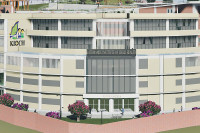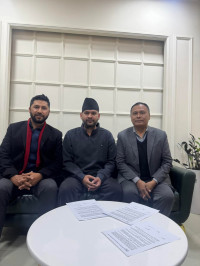Opinion
The day Ban Ki-moon cried
Have we done enough to support the earthquake victims in Nepal?
Surendra Bahadur Sijapati
It is hard to forget any disaster. In my living memory, I can recall two such calamities that have impacted humanity on an unprecedented scale. They are the January 2010 earthquake in Haiti and the April 2015 earthquake in Nepal. I was not in Haiti or in Nepal when the devastation occurred. However, the ingrained impact of these disasters is relevant, particularly on this very day.
Both Haiti and Nepal are still trying to recover from the quakes. My intention is neither to compare the two tragedies nor to blame anyone for the slow pace of recovery. I do want to ask, though, if we have done enough to support the quake victims in Nepal.
Haiti to heart
Nearly two months after the Haiti earthquake, seven years ago to the day on March 9, 2010, I was sitting on the ECOSOC Chamber in the UN Headquarters in New York as part of a team that organised a Haiti memorial for the quake victims and their families. Paying tribute to “the 101 heroes” from the podium decorated with white flowers, the then Secretary-General Ban Ki-moon started his speech with, “Dear colleagues, dear friends, above all the families of those to whom we sadly bid farewell...” and literally cried before he continued. We all cried along with the grieving families. To put it bluntly, the entire UN cried in solidarity.
Nearly five years later, on 12 April 2015, moments before entering my classroom in my college in London, a British colleague asked me, “Suren, don’t you know about the earthquake in Nepal?” I thought it was one of our usual morning exchanges. During a break, I found several missed calls from my wife in Kingston. She told me she was not able to contact home, and I feared the worst. Minute by minute coverage of the earthquake by global news channels realised our fears. It was real. With each passing moment, our hearts pounded louder and louder.
Over 7,000 kilometres away, I was helpless as I watched my country’s pain. But I saw unity in national efforts and an outpouring of international support. I saw the heroism of the security forces, exemplary social mobilisation, cooperation and stories of miracles. Above all, the sight of five-month-old Sonis Awal, rescued alive and held by a soldier of the Nepal Army, gave me hope.
Deep observations
In London, everyone who knew us sympathised by offering their sincere condolences and wishes for Nepal’s quick recovery. We had never imagined that people loved Nepal so much. Nepal started to receive significant support both from domestic and global communities. However, while the victims and their families were waiting desperately for support, we heard of procedural slackness and cases of misappropriation. Due to the lack of strategic thinking and focus on the “end”, we are still underutilising the “means” and are entangled in determining “ways”.
I love Yogeshwar Amatya’s song “Bhanchhan logne manchhe bhaera runu hunna re” (They say men shouldn’t cry). But listening to his song convinced me of the opposite—that men should cry if they choose. Ban Ki-moon further attested my viewpoint as I bore witness to his tears during the Haiti memorial in 2010. I wrote this article just to cherish the sentiment Ban Ki-moon shared with the families of the victims through his tears seven years ago. I hope this will bring forth Nepali tears and help us reach a consensus on working seriously towards improving the situation for Nepali earthquake victims.
It is a pity that those who are at the commanding heights of Nepal lack collective foresight, as proved by their sheer insensitivity towards the victims during the post-earthquake reconstruction period. National obligation to the families is poorly demonstrated by on and off, snail-paced, reconstruction schemes, often marred by issues such as the making of the constitution, blockades, bureaucratic impediments, political tug-of-wars and now, possibly the incoming local elections. Inefficiency in national management and resource mobilisation has made thousands of Nepali citizens suffer from rain and cold for two straight years. The resultant prolonged psychological trauma is incomprehensible.
Now, Nepali societies must pursue a new area of discourse by asking ourselves, “Have we done enough to support earthquake victims in Nepal?” I believe we are in for a long wait if we wish to see our leaders as emotionally invested as Ban Ki-moon was in 2010. Perhaps if they were invested, they could muster the moral courage to bring the derailed sense of humanity back on track.
Finally, we must draw lessons from selfless and unwavering acts of sympathy and support shown by people like Sitaram Kattel (Dhurmus) and Kunjana Ghimire (Suntali). Hopefully, we will learn to sympathise and help victims through acts of solidarity. Perhaps able leadership could bring about a change to inspire people and spur the populace to offer millions of helping hands for the less fortunate.
Sijapati is a graduate of the Royal College of Defence Studies, London and a former soldier in the Nepal Army




 11.12°C Kathmandu
11.12°C Kathmandu










%20(1).jpg&w=300&height=200)

